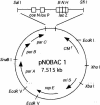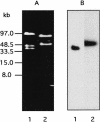A gene-enriched BAC library for cloning large allele-specific fragments from maize: isolation of a 240-kb contig of the bronze region
- PMID: 10854418
- PMCID: PMC310878
- DOI: 10.1101/gr.10.6.866
A gene-enriched BAC library for cloning large allele-specific fragments from maize: isolation of a 240-kb contig of the bronze region
Abstract
A generic bacterial artificial chromosome (BAC) library from a complex plant genome like maize may not be suitable for some types of genomic analysis, for example, for establishing correlations between the genetic and the physical organization of a given chromosome region. Previously, we carried out extensive genetic analysis of the bronze (Bz) region in Zea mays using a W22 inbred line carrying the Bz-McC allele; however, BAC libraries of that line are neither available nor under construction. Here, we report the isolation of large, adjacent BAC clones of this region from a partial BAC library of W22. We developed a BAC vector suitable for cloning NotI fragments and used it to clone size-fractionated genomic DNA that had been cut to completion with the methylation-sensitive, rare-cutting enzyme NotI. This strategy resulted in a very significant enrichment of large genic DNA. From a library of about 20,000 BACs, containing just two-thirds of a maize genome, we isolated 16 BAC clones of the 110-kb distal Bz fragment and 10 BAC clones of the 130-kb proximal Bz fragment. This recovery means that our strategy resulted in a 15- to 24-fold enrichment of specific sequences. The order of the BAC clones in the 240-kb contig, predetermined from an internal NotI site in the Bz-McC allele was confirmed by hybridization with sequences from sites previously mapped proximal and distal to Bz and by sequencing. To show the general utility of our approach and the value of our partial BAC library, we also isolated BAC clones of other sequences, such as tub4 and the complex R-r allele, contained in the same size fraction of DNA. This is the first report of the use of a BAC vector to clone allele-specific large DNA fragments from a plant with a large genome, circumventing the need to construct a complete BAC library.
Figures






Similar articles
-
Construction and characterization of a bacterial artificial chromosome library of Sorghum bicolor.Nucleic Acids Res. 1994 Nov 25;22(23):4922-31. doi: 10.1093/nar/22.23.4922. Nucleic Acids Res. 1994. PMID: 7800481 Free PMC article.
-
Pseudomonas aeruginosa PAO1 bacterial artificial chromosomes: strategies for mapping, screening, and sequencing 100 kb loci of the 5.9 Mb genome.Microb Comp Genomics. 1998;3(2):105-17. doi: 10.1089/omi.1.1998.3.105. Microb Comp Genomics. 1998. PMID: 9697095
-
Method for cloning restriction fragments containing the termini of BAC inserts.Biotechniques. 2000 May;28(5):1012-6, 1018. doi: 10.2144/00285rr07. Biotechniques. 2000. PMID: 10818709
-
Construction of an 800-kb contig in the near-centromeric region of the rice blast resistance gene Pi-ta2 using a highly representative rice BAC library.Mol Gen Genet. 1997 May;254(6):611-20. doi: 10.1007/s004380050459. Mol Gen Genet. 1997. PMID: 9202377
-
Bacterial artificial chromosome cloning and mapping of a 630-kb human extrachromosomal structure.Genome Res. 1996 Jul;6(7):612-9. doi: 10.1101/gr.6.7.612. Genome Res. 1996. PMID: 8796348
Cited by
-
The highly recombinogenic bz locus lies in an unusually gene-rich region of the maize genome.Proc Natl Acad Sci U S A. 2001 Jul 17;98(15):8903-8. doi: 10.1073/pnas.141221898. Epub 2001 Jul 3. Proc Natl Acad Sci U S A. 2001. PMID: 11438686 Free PMC article.
-
A maize sesquiterpene cyclase gene induced by insect herbivory and volicitin: characterization of wild-type and mutant alleles.Proc Natl Acad Sci U S A. 2000 Dec 19;97(26):14807-12. doi: 10.1073/pnas.240284097. Proc Natl Acad Sci U S A. 2000. PMID: 11106370 Free PMC article.
-
Intraspecific violation of genetic colinearity and its implications in maize.Proc Natl Acad Sci U S A. 2002 Jul 9;99(14):9573-8. doi: 10.1073/pnas.132259199. Epub 2002 Jun 11. Proc Natl Acad Sci U S A. 2002. PMID: 12060715 Free PMC article.
-
Construction and characterization of a bacterial artificial chromosome library for the A-genome of cotton (G. arboreum L.).J Biomed Biotechnol. 2010;2010:457137. doi: 10.1155/2011/457137. Epub 2010 Aug 23. J Biomed Biotechnol. 2010. PMID: 20827418 Free PMC article.
-
Remarkable variation in maize genome structure inferred from haplotype diversity at the bz locus.Proc Natl Acad Sci U S A. 2006 Nov 21;103(47):17644-9. doi: 10.1073/pnas.0603080103. Epub 2006 Nov 13. Proc Natl Acad Sci U S A. 2006. PMID: 17101975 Free PMC article.
References
-
- Arumuganathan K, Earle ED. Nuclear DNA content of some important plant species. Plant Mol Biol Reporter. 1991;9:208–218.
-
- Bennetzen JL, Schrick K, Springer PS, Brown WE, SanMiguel P. Active maize genes are unmodified and flanked by diverse classes of modified, highly repetitive DNA. Genome. 1994;37:565–576. - PubMed
-
- Budiman, M.A., J.P. Tomkins and R.A. Wing. 1999. Construction and characterization of rice Nipponbare BAC library. URL: http://www.genome.clemson.edu/rice_frame.html.
Publication types
MeSH terms
Substances
LinkOut - more resources
Full Text Sources
